|
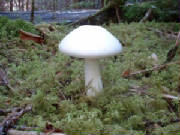
|
| The Destroying Angel,Amanita virosa. |
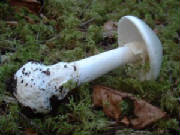
|
| The Destroying Angel, Amanita virosa. |
Toxins that cause liver damage.
Nova Scotia is home to some fine edible mushrooms,some poisonous ones and also some deadly ones. There is a distinction
between poisonous and deadly and it is in this section that I will outline the differences.
The genus Amanita contains some of the deadliest mushroms in Nova Scotia and are responsible for most of
the deaths in N.America due to mushroom poisoning.The three white Amanita's namely,Amanita phalloides,A.verna and
A.virosa(The Destroying Angel) are closely related species and contain the toxins Amatoxin and Phallotoxin. These
toxins have also been found in the genus Lepiota and also Galerina.The toxins attack the liver and are particularly
insiduous as the symptoms don't appear for some length of time,usually between 8 and 24 hours after eating. It has been estimated
that one fully developed mushroom has the potential to kill two people. The first signs of poisoning are vomiting and diarhhea.
These symptoms may last for up to 48 hours. After which these symptoms dissapear and symptoms of liver dysfunction set in.
This period is critical for the treatment of the victim. If urgent medical attention is not received the victim succumbs to
unconciousness and death usually occurs on the fifth or sixth day.
Muscarine poisoning.
Initially the poison's name was taken from the mushroom that contains the toxin; Amanita muscaria.But
it is now known that Ibotenic acid and Muscimol are the primary toxins in A.muscaria and A.pantherina In
Nova Scotia we have two varieties of Amanita muscaria. One of which is yellow,Amanita muscaria var formosa which
is by far the more common of the two. And we also have Amanita muscaria var muscaria which in my experience is rather
rare,being apparently more of a western species.
|
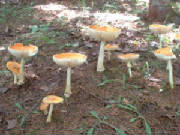
|
| Yellow-orange Fly Agaric,Amanita muscaria var formosa. |
|
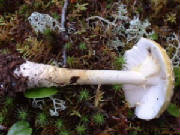
|
| Yellow-orange Fly Agaric, Amanita muscaria var formosa. |
|
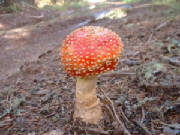
|
| Fly Agaric,Amanita muscaria var muscaria. |
|
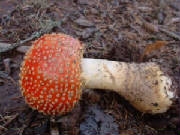
|
| Fly Agaric, Amanita muscaria var muscaria. |
|
It has been discovered fairly recently that Amanita muscaria (photograph above) and also A.pantherina
have only small quantities of the toxin muscarine. On the other hand muscarine was found in large quantities in the genera
Inocybe and Clitocybe. Of the genus Inocybe, both I.lacera and I.geophylla contain
large amounts of muscarine and both are known to grow in Nova Scotia.
Poisoning due to muscarine sometimes appears while the meal is still being eaten but usually within two hours
after ingestion.Symptoms include heavy pespiration,salivation,vomiting and diarrhea.Deaths are known from this type of poisoning.
Ibotenic Acid and Muscimol.
As stated elsewhere above, poisoning's occur primarily from A.muscaria and A.pantherina. The symptoms
become apparent as little as thirty minutes after ingestion and can take up to two hours. The rather unpleasant
symptoms include delusions,uncontrolled muscular co-ordination,cramps and deep sleep.
Hospitalisation is sometimes required and recovery takes up to 24 hours or longer.
Gyromitrin Poisoning
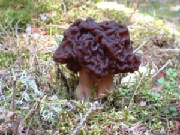
|
| Conifer False Morel, Gyromitra esculenta. |
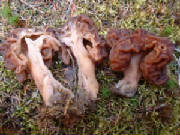
|
| Conifer False Morel, Gyromitra esculenta. |
The Conifer False Morel,Gyromitra esculenta,photographs at left, is one of our Spring mushrooms. There
has been a lot written about this particular mushroom as regards it's edibility. It should be treated as DEADLY.
For a long time it was thought that the toxin involved was Helvellic acid. This has since been discounted
and the toxin that was isolated was named gyromitrin which quickly metabolises in to the very poisonous monomethylhydrazine.
Symptoms do not usually occur until six to twelve hours after ingestion. The symptoms include,diarrhea, a bloated feeling,dizziness
and loss of coordination. In severe cases death can occur, which is preceded by convulsions and coma.
Psilocybin and Psilocin poisoning.
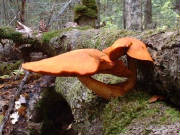
|
| Mature specimens of Big Laughing Gym,Gymnopilus spectabilis. |
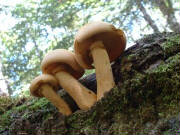
|
| Immature specimens of Big Laughing Gym,Gymnopilus spectabilis. |
There are several genera which contain Psilocybin amd Psilocyn. Psilocybe,which is probably the best
known of them all, is common in Nova Scotia and could be categorised as an L.B.M ,(Little Brown Mushroom)
all little brown mushrooms are difficult to tell apart,even for an expert. The mushrooms containing these toxins are known
for their hallucinogenic effects and are considered poisonous. The amount of toxin varies widely from species to
species, and as previously stated they are difficult to tell apart.Other genera known to contain these toxins are Stropharia,Gymnopilus,Conocybe
and Panaeolina (formerly Psathyrella).
Symptoms usually appear within an hour of ingestion and can have extreme variations.Some people experience euphoria,others
fear or anxiety. Sight disorders,visions and delusions are common. The combination of some of these effects may lead
to delirium and suicide attempts.
Orellanin Poisoning caused by the genus Cortinarius.
The toxin Orellanin takes it's name from Cortinarius orellanus. The first poisoning being attributed to it in
Poland in the early 1960's. As far as I am aware C.orellanus does not grow in Nova Scotia. Unfortunately this is
cold comfort. Cortinarius is a large genus containing up to 800 species in North America with only about half of them being
described.It is estimated there are between 200-300 species in Nova Scotia. Since the first poisoning with C.orellanus
many Cortinarius species have been found to contain this toxin. It also follows that as more species are described and their"attributes"
recognised, the list of poisonous species within this genus will undoubtably increase. Some field guides list various species
of Cortinarius as edible and some field guides come down on the side of caution and say that you should not consume any species
that belong to this genus. Since there are a lot of look-alikes within this genus I believe that it is always best to err
on the side of caution. Personally I would not eat any species from this genus.
Symptoms of Orellanin poisoning usually take quite some time to manifest themselves and it may take up to two weeks or
longer before the victim feels unwell.It follows that the victim doesn't usually make the connection between the ingestion
of the mushrooms and the onset of symptoms.Orellanin poisoning affects the kidneys and can cause kidney failure. Some of the
symptoms include an over production of urine, at first, which slows down and ultimately stops altogether. Death occurs
from renal failure.
Shown below are two members of the Cortinarius genus. C.semisanguineus shows the cobwebby remnants of
the veil,the cortina.The cortina is much easier to see in immature specimens (before the cap has expanded). While
C.alboviolaceus shows the cortina around the stalk after the cap has fully expanded.
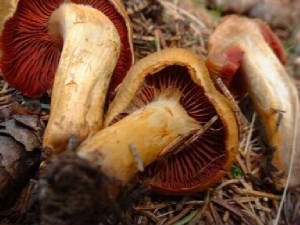
|
| Red Gilled Cort, Cortinarius semisanguineus. |
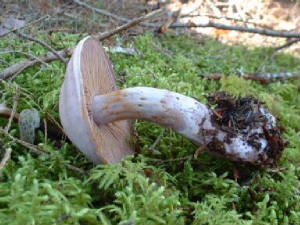
|
| Silvery Violet Cort, Cortinarius alboviolaceus. |
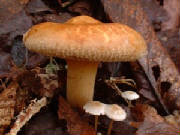
|
| PoisonPaxillus, Paxillus involutus. |
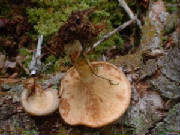
|
| Poison Paxillus, Paxillus involutus. |
Poisoning of the immune system by Paxillus involutus.
For many years people in Eastern and Central Europe ate this mushroom with apparent impunity. It was not until the
late 1940's that it's edibility was brought in to question. It is now known that people who have eaten this mushroom for many
years develop an allergic reaction to it and it attacks red blood cells resulting in kidney failure. This is a common mushroom
in Nova Scotia and obviously should not be eaten.
Mushrooms containing various unknown toxins
Because of the various toxins involved,the amount ingested and the general health of the victim it is difficult to be
precise about the various symptoms involved. However,in general the symptoms will include nausea,diarrhea,vomiting and
abdominal pain. Recovery may be within a few hours or a few days depending on the circumstances outlined above.The mushrooms
photographed below are some of the many mushrooms that have unknown toxins contained in them. These are but a representative
portion of the more common toxic mushrooms that grow in Nova Scotia.
|
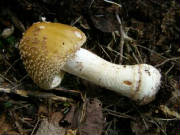
|
| Cleft Foot Amanita, Amanita brunnescens. |
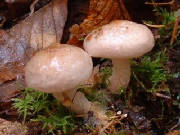
|
| Poison Pie, Hebeloma crustiliniforme. |
|
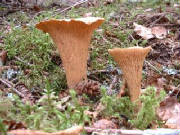
|
| Scaly Vase Chanterelle, Gomphus floccosus. |
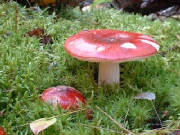
|
| Emetic Russula, Russula emetica. |
|
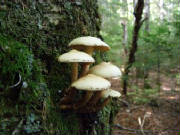
|
| Sulfur Tuft, Naematoloma fasciculare. |
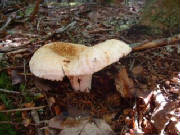
|
| Pink Fringed Milky, Lactarius torminosus. |
|
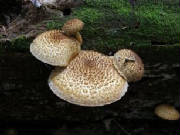
|
| Sharp Scaly Pholiota,Pholiota squarrosoides. |

|
| Pigskin Poison Puffball, Scleroderma citrinum. |
|
Rhabdomyolysis caused by Tricholoma equestre.
Rhabdomyolysis caused by Tricholoma equestre or
as it is also known T.flavovirens.
Some of the common names which this mushroom is
known by are “Man on Horseback”, “Canary Trich” and “Yellow Knight”.
Between 1992 and the year 2000 twelve people
in south west France were hospitalised for severe weakness and muscle loss. The connecting link was that they had all eaten
significant quantities of T.equestre. Of the twelve people affected, three died.
I have found this mushroom in Nova Scotia
several times. Some older Field Guides that I have list this mushroom as a good edible. To complicate things just a little
bit more, for the unwary, this mushroom could be confused with Tricholoma sejunctum. This is another mushroom that I have
also found with some frequency.Depending on the Field Guide you are using this mushroom has also been listed at one time or
another as being edible.
To summarise; depending on
your Field Guide.
-
One of these mushrooms could be described as
edible.
-
Both could be described as edible.
-
Both could be described as inedible.
If you have any doubts about a mushrooms identity
and/or it's edibility you should always err on the side of caution and not eat
it.
Both mushrooms are pictured below.
|
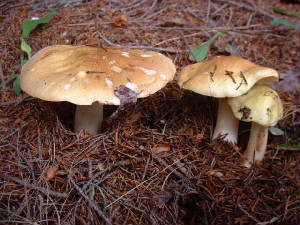
|
| Man on Horseback, Tricholoma equestre. |
|
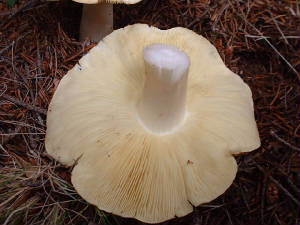
|
| Man on Horseback, Tricholoma equestre. |
|
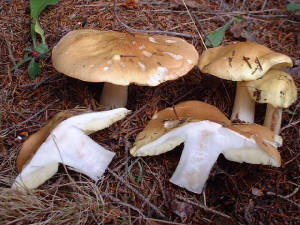
|
| Man on Horseback, Tricholoma equestre. |
|
|
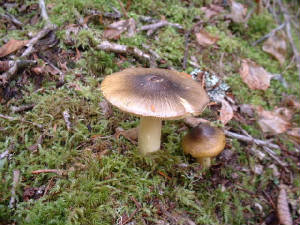
|
| Seperating Trich, Tricholoma sejunctum. |
|
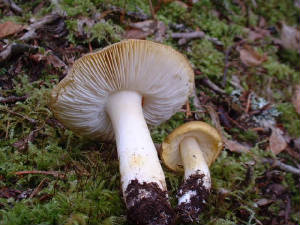
|
| Seperating Trich, Tricholoma sejunctum. |
|
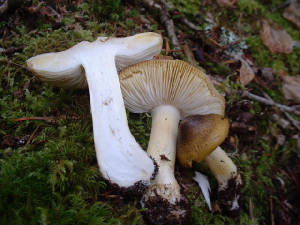
|
| Seperating Trich, Tricholoma sejunctum. |
|
|




